#for loop in py
Explore tagged Tumblr posts
Text
A random headcanon for y'all on this chilly morning, about how the muses walk with their s/o!
Jaspern is the type of person to, while walking with his s/o, keep a hand in their back pocket, to keep them close to him. Very effortless and smooth, but also affectionate. Same with Io, I feel. Also JJ, because he grew up seeing Jas do that, tbh.
Pythius is similar, but he's more likely to hook his fingers in his s/o's belt loops to tug them over, before putting an arm around their waist or something. If he's walking behind them, he'll do it if he needs to "steer" them a little, or wants them to slow down. ("I want attention", essentially) Aro, Zikiriel, and Sarakael also do this one, on occasion.
Aro and Eleare will curl their tail (or a few of them) around their s/o, or drape one over their shoulders. Or will alternatively stand/lay on their s/o's shoulders in their little fox forms.
Cilatyve actually doesn't care too much for flat out holding hands-- he uses his to navigate too much to feel super comfortable with that, especially if he trips or something. Instead, he likes to coil his tail around their thigh, wrist, or arm. Arin and Jaey, if their tails are out, will also curl the end around their s/o's wrist or thigh when walking. Otherwise, it's more common for them to just coil around their s/o entirely once they've settled from going somewhere together.
Zikiriel will, instead of wrapping an arm around his s/o, keep a wing curled around them sometimes. Keeps them close, and gives them a bit of privacy on top of that (he's not a fan of people staring at his s/o, sue him)
Nirbhi, Ezra, and Sarakael like to keep their hand their s/o's back while they're walking, or occasionally rested on their shoulder. That way, they and their partner can walk at whatever pace they want! But if something happens, it's easy enough to tug their shirt or give them a little nudge or something to avoid or draw attention to whatever it is.
Enoch, Pereux, Bleddyn, and Shilo tend to shift positions when they're walking with their s/o a lot. Eno and Jinnie tend to walk slightly behind, Bleddyn slightly in front, and Shilo not really having a preference...but if someone unknown approaches their s/o, or they go to pass someone, etc, they'll automatically move to position themselves between the other person and their s/o. Actually, Kade also fits here. Huh. That's a lot more muses than I'd thought would be put here.
Baphomet...man, I don't know. He's clingy. As always. Please be careful not to trip. Niesal can surprisingly also get like this, when they actually fall for someone, so I guess it's hereditary.
Sivel and Alsina, when walking around with (or especially traveling with) their s/o, their wings will almost always be buzzing in a very specific pattern. It's sort of announcing that they're with their person. And that they're excited, because they're going somewhere. With their person! They don't even realize they're doing it, honestly.
Fele and Laisren tend to do the more refined offering an arm to their s/o. Keeping them at a slight distance, and separating to take their hand instead to help them down stairs, or over a curb or puddle, or whatever else.
Zahine (and Kade and JJ, during the times that they're not in their other categories) likes to do the closer linked arms thing. Where he has one arm linked with his s/o's, and he's leaned on them or encouraging them to lean on him a little while they walk. Makes it easy to sneak a cheek kiss or something in, if he wants to!
Ber, Eluvias, Ezzion, and Vanyllo tend not to touch their s/o much while they're walking. Luvi, because he's used to not being able to touch people much without them being hurt by his poison. The other three...mostly just because they don't want to, for one reason or another. All four of them do constant check-ins, though-- looking back at their partner frequently, or engaging in really brief touches, to make sure they're doing alright. Another thing they tend to do is that little "curls their just the tips of their fingers with their s/o's" thing whenever they stop or slow down. As a sort of "I'm still with you" thing.
#[Muse headcanons]#I ain't tagging all of them I'm too lazy lmao#but yeah this was triggered by me being reminded of Jas' back pocket and Py's belt loop thing#also because I realized the Shilo one last night#some of these are also somewhat dependent on the s/o but are overall what the muses will default to more often than not#so yeah just a cute little thing
5 notes
·
View notes
Text
'computers/programs cant make decisions or think for themselves' wrong actually they love making decisions to not work like i coded them to Ever
#my beautiful son authenticationsystem dot py he has every logic error known to man#'why does this code not work how i want it to' <- person who used 8 NESTED LOOPS#like damn bitch i wonder why#I Love Programming. Heart emoji.#nova.txt
1 note
·
View note
Text
Mannequins, Ball-Jointed Dolls, and Computer Program ID Pack
[PT: Mannequins/Ball-Jointed Dolls and Computer Program ID Pack /PT End]


[ID 1: A picture of a computer being programmed. ID End]
[ID 2: A divider made up of white bows, hair clips, and beads in alternating order. ID End]
Names: Ajax, Al, Alexis, Babe, Belle, Blaire, Cadenza, Cassie, Charlotte, Cody, Delphina, Fey, Flo, Gabby, Gabi, Gwen, Hal, Iris, Jack, Jenny, Kiki, Lacey, Lainey, Lyka, Mac, Malachi, Mari, Marion, Nana, Nano, Pixel, Poppy, Quinn, Ruby
[PT: Names /PT End]
Pronouns: 404/404s, ball/joints, block/chain, bot/bots, bow/bows, bug/bugs, cloud/clouds, cute/cutie, doll/dolls, dress/up, fae/faes, flirt/flirts, frail/frails, frill/frills, git/github, HTML/HTMLs, java/javascript, lace/laces, loop/loops, pix/pixels, pose/pose, py/thons, ruby/rails, sprint/sprints, stiff/stiff, thon/thons, toy/toys, uni/corn, URL/URLs, w3b/w3bs,API/APIs 🦄/🦄's, 🐍/🐍's, 🕸️/🕸️'s, 💻/💻's, 🖥️/🖥️s, 🔌/🔌's, ☘️/☘️'s, 🪆/🪆's
[PT: Pronouns /PT End]
Titles: [Prn] Who Dresses Pretty, [Prn] Who Is Posed, Digital Doll, Doll That Is Digital, The Doll With The Errors, The Dress-Up Doll, The Painted Doll, The Programmed Doll, The Ball Jointed One
[PT: Titles /PT End]
Labels: AI Flag, Alderpollint, Balldollgirlinwayven, Balljointdollfuckoff, Balljointlovia, BJD Presentic, BJD System, BJDgender, BJDollgoth, Bunballdollic, Digiminalwebic, Doll Copinglink/Otherlink, Doll4Robot/Robot4Doll, DollDigital, Dollisque, Gendercodex/Codegender, Genderprogram, Gendersoftware, Idollgender, Machinedollkin, Mannedroidous, Mannequinic, Porcelicce, Robodollgender, Robotthing, Sentient AI, Tearjointic, HTMLgender
[PT: Labels /PT End]
Requested by @virtualcrosier !! :3

[ID 3: A divider made up of white bows, hair clips, and beads in alternating order. ID End]
divider credit(link)
#I HOPE THIS FITS WHAT YOU WANTED !!!#i may make some labels based off these themes would you like to be tagged when i post them? ^_^#id pack#tech id pack#computer id pack#digital id pack#computer npt#digital npt#tech npt#doll npt#doll id pack#mannequin id pack#mannequin npt#npt#tina's id packs
38 notes
·
View notes
Text
So while working through game concepts and deciding what to work on next, I've been refreshing my Godot skills. Wanting to get back into 3D and prepare for doing more narrative heavy games. Made this demo to learn nathanhoad's excellent Dialogue Manager addon and also test drive Kenney's new Godot platformer kit.
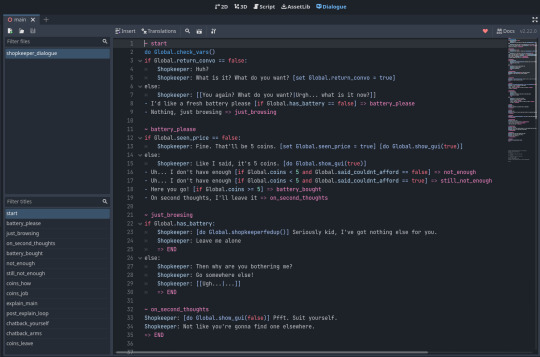
I'm really, really enjoying Dialogue Manager so far and feel it has a tonne of potential. Think it covers a lot of things I've been looking for:
Direct engine integration is super useful, as well as using custom resources to store dialogue. They're also text files so can still use external editor to update
Straightforward syntax, reminds me a lot of ink and yarn. As well it's named node approach feels familiar
Able to access global game variables for conditionals, and having conditional based loops and choices is very straightforward
Also able to call methods directly within dialogue, which is super powerful when combined with signals (showing/hiding coin UI mid conversation, playing sound effect)
Lots of options for random dialogue choices - just used the single line ones for now but in docs have seen they also have option for setting custom probabilities, just ncie to add more flavour
Hyped it has a built in approach for translations (create IDs and reference CSVs) that looks like integrates with Godot's localisation tools - a bit of a future thought but glad it has stuff to help built in
Docs you can mention you can create dialogue resources at runtime. Can imagine this being very useful - an example would be creating a record of all lines seen to replicate Ren-py's "log" feature.
The methods for displaying dialogue are super flexible. At the moment just used their example balloons but looks like it should play nicely to let you build custom GUI - and maybe even multiple forms (e.g. dialogue scenes vs flavour barks in main game world). Think next experiments will focus on this.
There's a few more things I'm keen to learn and see if they're feasible with this - "disabled" choices that still appear but can't be accessed would be nice, also looking at how you can integrate this with an audio system for voice acting - I think they have an example that includes voice acting?
Only thing I'm a bit nervous of is it looks like it can only grab variables from autoload/global scripts, so when putting into actual game will need to take care with save systems and methods for loading choice variables into a choice master global so we aren't keeping too much in memory at once. But if I'm wrong on this assumption, or others have approaches, more than happy to be corrected on this!
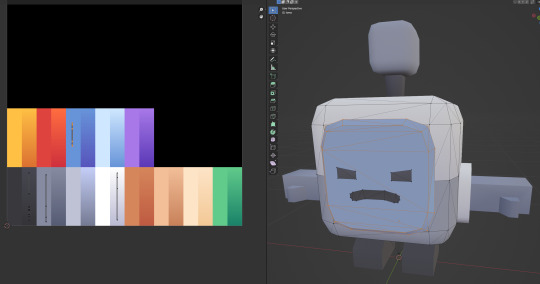
Also really enjoying Kenney's 3D platformer kit and it's been fun and . Making the shopkeeper bot was super simple. All the details on the original character model are modelled so just adjusted the face and for changing colours just had to move UV islands for limbs and face to different parts of the pallete textures.
Haven't tried this technique for modelling and texturing before but seen it crop up a few times so will definitely experiment with this in the future. Also might help with optimization - I think most of the materials in the pack refer to this single image texture? By default the pack only has the model glbs and a single colormap png so assuming that's how it's working.
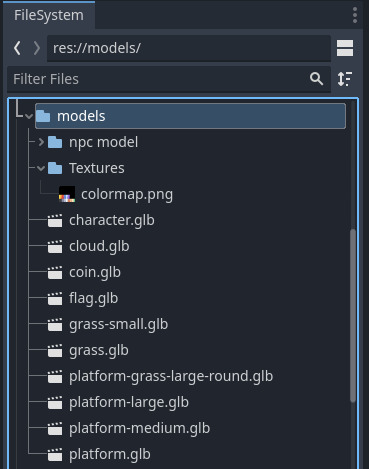
Original plan was to fill in the shop with another pack so there's a few little platform challenges within this, but they all needed collisions adding so might add that in future. But main aim was focusing on the dialogue and think we've got a good approch going forward, and highly recommend the add on for other Godot devs making narrative games!
#Godot#game dev#godot 4#game development#dev log#game dev experiment#interactive fiction#dialogue system
38 notes
·
View notes
Text
me being unreasonably negative about one paragraph in a mostly good post

Hooray! Huge swathes of interesting mods will be unusable with quality and recycling, and it will likely become the default to just not use it, maybe even for mods to not bother supporting it.
I was starting to come around on quality. The idea of different planets potentially having infinite of specific resources suggested to me that you could make an interplanetary mall instead of each planet just being a one science pony. Make your legendary chemical plants on the planet with infinite iron and copper but limited hydrocarbons. It just makes sense. The same-loop-for-every-building thing is still an affront to my game design instincts but shipping around a diversity of finished and semi-finished products is always conceptually compelling to me.
Idk, they're allowed to have their vision, but "btw the expansion is intrinsically hostile to Alternate Recipes As A Concept" feels like a baffling disconnect from what their community demonstrably enjoys in complexity-additions. I guess they're assuming the py superfans would scoff at anything newbie-legible?
This makes me less excited about the remaining planets, I was hoping some would be completely lacking in some key resource and you would have to get up to some ISRU shit, actually making things from different materials instead of just getting the same materials from a different route. but this one paragraph kind of just dashed the hope of that possibility.
The new buildings are rad, though. Can't deny that.
17 notes
·
View notes
Text
Bunny Linguistic Adventure | #3days1project

Sunday 18th June 2023
Back with another Python project! Wanted to make a puzzle-like adventure game! Of course, now I know how to add colour to the text, I made it cute-themed (or I tired, I don't know anymore)!

The main focus of this project was working on importing other .py files in the folder, while loops and using string methods like .upper(), .lower()! It's going to come up in my future uni work so I'm glad I scanned over this topic with this project!
Anyhoo, here is the project!

The links:
The source code | The page live | My #3Days1Project page

Here are the resources I used:
Add colour to Python text - LINK
Where I got the bunny art - LINK
Thank you for reading, have a nice day/night, and happy programming! 😌💻💗
#3days1project#codeblr#coding#programming#progblr#studying#studyblr#comp sci#tech#computer science#python
13 notes
·
View notes
Note
🎁- give a gift
Dez, absolutely elated, scoops Maeve up into his arms and plants kisses all over her face.
"HAP!" kiss "PY!" kiss "BIRTH!" kiss "DAY!"
When he places her back on his feet, he produces a long slim box from the inner pocket of his jacket. It's wrapped in a deep navy blue paper and topped with a silver ribbon.
Inside Maeve would find a delicate silver chain. As she lifts it from the box she would see the phases of the moon in hammered silver hanging vertically, attached to another silver chain.
"You wear it like this" Dez explains. The first loop goes on like a regular necklace. The moon phases sit against the centre of Maeve's chest and glide down her abdomen, while the bottom chain circles around her waist and sits just over her hips.
"Miz said you can wear it against your chest or your back, over clothes or" he grins "while wearing nothing at all"
@misery-lake
She laughed as her heels hit the floor with a soft click, her eyes lighting up at the box, puzzling away quietly at what use she would find for the ribbon.
As Dez looped the chain around her body, fingers feather light, she felt her skin buzz and her lips curl into a smile, then a grin. The grin became teasing at his final words.
"You're incorrigible," she said with a laugh, fingers grazing the moon phases. He waggled his eyebrows in response. "Tell Miz I said thank you as well, I'll be finding much use out of this." Her smile became suggestive before becoming sweet again.
"And thank you, mo chroí," she murmured, rising onto her tiptoes to kiss his cheek softly. "I love you."
#they :}#asks#answered#maeve's witching hour birthday#moonstruck#maeve x dez#they indeed got a LOT of use out of that <3#thank you!!!!!!!!!!#:D
3 notes
·
View notes
Text
XENOBLADE 3 SPOILER!!!!
I've been thinking about it since I first played Xenoblade 3 when it came out. But do you ever think about the way it actually hinted from the beginning that they have been repeating their lives over and over again. The ennemis in this game are called "Moebius" and in their eyes can see the "Moebius circle ♾️". In literature you can encounter it.
I read a theater piece with this process in it once. It was about a theater troupe repeating for a theater piece and having an argument because 'it is always the same person that has the more text', 'the best part and characters' ect. They have a pretty big argument and dispatch away, then happen the end of the piece, the stage director comes with a new piece and call all his actors back, give them the piece and their new role, and then with only that you can figure out that the same thing that happened at the beginning of the piece going to happen again and again. You can repeat this piece over pand over. That's what we call the Moebius circle
Okay now back to Xenoblade 3. Now think about the fact they are called Moebius and that the character's life is an endless loop that repeats itself. Everything makes sense.
(The theater piece is called 'illusions comiques' by Olivier Py.)
#Xenoblade 3#Xenoblade Chronicles#Xenoblade Chronicles 3#Moebius#Noah Xenoblade#Mio Xenoblade#xenoblade 3 spoilers#Spoilers
4 notes
·
View notes
Text
Ultimate Guide to Python Compiler

When diving into the world of Python programming, understanding how Python code is executed is crucial for anyone looking to develop, test, or optimize their applications. This process involves using a Python compiler, a vital tool for transforming human-readable Python code into machine-readable instructions. But what exactly is a Python compiler, how does it work, and why is it so important? This guide will break it all down for you in detail, covering everything from the basic principles to advanced usage.
What is a Python Compiler?
A Python compiler is a software tool that translates Python code (written in a human-readable form) into machine code or bytecode that the computer can execute. Unlike languages like C or Java, Python is primarily an interpreted language, which means the code is executed line by line by an interpreter. However, Python compilers and interpreters often work together to convert the source code into something that can run on your system.
Difference Between Compiler and Interpreter
Before we delve deeper into Python compilers, it’s important to understand the distinction between a compiler and an interpreter. A compiler translates the entire source code into a machine-readable format at once, before execution begins. Once compiled, the program can be executed multiple times without needing to recompile.
On the other hand, an interpreter processes the source code line by line, converting each line into machine code and executing it immediately. Python, as a high-level language, uses both techniques: it compiles the Python code into an intermediate form (called bytecode) and then interprets that bytecode.
How Does the Python Compiler Work?
The Python compiler is an essential part of the Python runtime environment. When you write Python code, it first undergoes a compilation process before execution. Here’s a step-by-step look at how it works:
1. Source Code Parsing
The process starts when the Python source code (.py file) is written. The Python interpreter reads this code, parsing it into a data structure called an Abstract Syntax Tree (AST). The AST is a hierarchical tree-like representation of the Python code, breaking it down into different components like variables, functions, loops, and classes.
2. Compilation to Bytecode
After parsing the source code, the Python interpreter uses a compiler to convert the AST into bytecode. This bytecode is a lower-level representation of the source code that is platform-independent, meaning it can run on any machine that has a Python interpreter. Bytecode is not human-readable and acts as an intermediate step between the high-level source code and the machine code that runs on the hardware.
The bytecode generated is saved in .pyc (Python Compiled) files, which are stored in a special directory named __pycache__. When you run a Python program, if a compiled .pyc file is already available, Python uses it to speed up the startup process. If not, it re-compiles the source code.
3. Execution by the Python Virtual Machine (PVM)
After the bytecode is generated, it is sent to the Python Virtual Machine (PVM), which executes the bytecode instructions. The PVM is an interpreter that reads and runs the bytecode, line by line. It communicates with the operating system to perform tasks such as memory allocation, input/output operations, and managing hardware resources.
This combination of bytecode compilation and interpretation is what allows Python to run efficiently on various platforms, without needing separate versions of the program for different operating systems.
Why is a Python Compiler Important?
Using a Python compiler offers several benefits to developers and users alike. Here are a few reasons why a Python compiler is so important in the programming ecosystem:
1. Portability
Since Python compiles to bytecode, it’s not tied to a specific operating system or hardware. This allows Python programs to run on different platforms without modification, making it an ideal language for cross-platform development. Once the code is compiled into bytecode, the same .pyc file can be executed on any machine that has a compatible Python interpreter installed.
2. Faster Execution
Although Python is an interpreted language, compiling Python code to bytecode allows for faster execution compared to direct interpretation. Bytecode is more efficient for the interpreter to execute, reducing the overhead of processing the raw source code each time the program runs. It also helps improve performance for larger and more complex applications.
3. Error Detection
By using a Python compiler, errors in the code can be detected earlier in the development process. The compilation step checks for syntax and other issues, alerting the developer before the program is even executed. This reduces the chances of runtime errors, making the development process smoother and more reliable.
4. Optimizations
Some compilers provide optimizations during the compilation process, which can improve the overall performance of the Python program. Although Python is a high-level language, there are still opportunities to make certain parts of the program run faster. These optimizations can include techniques like constant folding, loop unrolling, and more.
Types of Python Compilers
While the official Python implementation, CPython, uses a standard Python compiler to generate bytecode, there are alternative compilers and implementations available. Here are a few examples:
1. CPython
CPython is the most commonly used Python implementation. It is the default compiler for Python, written in C, and is the reference implementation for the language. When you install Python from the official website, you’re installing CPython. This compiler converts Python code into bytecode and then uses the PVM to execute it.
2. PyPy
PyPy is an alternative implementation of Python that features a Just-In-Time (JIT) compiler. JIT compilers generate machine code at runtime, which can significantly speed up execution. PyPy is especially useful for long-running Python applications that require high performance. It is highly compatible with CPython, meaning most Python code runs without modification on PyPy.
3. Cython
Cython is a superset of Python that allows you to write Python code that is compiled into C code. Cython enables Python programs to achieve performance close to that of C while retaining Python’s simplicity. It is commonly used when optimizing computationally intensive parts of a Python program.
4. Jython
Jython is a Python compiler written in Java that allows Python code to be compiled into Java bytecode. This enables Python programs to run on the Java Virtual Machine (JVM), making it easier to integrate with Java libraries and tools.
5. IronPython
IronPython is an implementation of Python for the .NET framework. It compiles Python code into .NET Intermediate Language (IL), enabling it to run on the .NET runtime. IronPython allows Python developers to access .NET libraries and integrate with other .NET languages.
Python Compiler vs. Interpreter: What’s the Difference?
While both compilers and interpreters serve the same fundamental purpose—turning source code into machine-executable code—there are distinct differences between them. Here are the key differences:
Compilation Process
Compiler: Translates the entire source code into machine code before execution. Once compiled, the program can be executed multiple times without recompilation.
Interpreter: Translates and executes source code line by line. No separate executable file is created; execution happens on the fly.
Execution Speed
Compiler: Generally faster during execution, as the code is already compiled into machine code.
Interpreter: Slower, as each line is parsed and executed individually.
Error Detection
Compiler: Detects syntax and other errors before the program starts executing. All errors must be fixed before running the program.
Interpreter: Detects errors as the code is executed. Errors can happen at any point during execution.
Conclusion
The Python compiler plays a crucial role in the Python programming language by converting source code into machine-readable bytecode. Whether you’re using the default CPython implementation, exploring the performance improvements with PyPy, or enhancing Python with Cython, understanding how compilers work is essential for optimizing and running Python code effectively.
The compilation process, which includes parsing, bytecode generation, and execution, offers various benefits like portability, faster execution, error detection, and optimizations. By choosing the right compiler and understanding how they operate, you can significantly improve both the performance and efficiency of your Python applications.
Now that you have a comprehensive understanding of how Python compilers work, you’re equipped with the knowledge to leverage them in your development workflow, whether you’re a beginner or a seasoned developer.
0 notes
Text
Mikrocontroller ESP32C3 von Seeed Studio
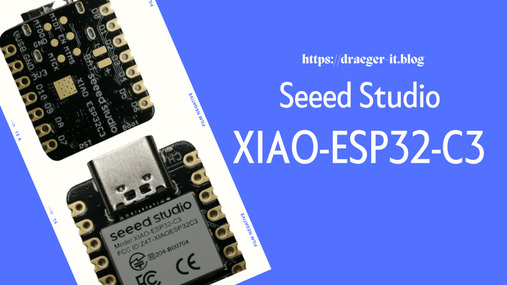
In diesem Beitrag möchte ich dir den Mikrocontroller ESP32C3 von der Firma Seeed Studio vorstellen.

Dieser Mikrocontroller trägt durch seine geringen Abmaße mal wirklich zurecht die Bezeichnung "Mikrocontroller".

ESP32-C3 von Seeed Studio

ESP32-C3 von Seeed Studio (Rückseite) Von der Firma Seeed Studio habe ich dir bereits den Seeed Studio XIAO RP2040 – ein Zwerg mit großer Leistung vorgestellt, welcher die gleichen Abmaße hat, wie der hier gezeigte ESP32C3.

Vergleich XIAO RP2040 mit ESP32-C3 von Seeed Studio
Bezug des ESP32C3 von Seeed Studio
Den mir vorliegenden Mikrocontroller habe ich auf berrybase.de für 8,45 € zzgl. Versandkosten erstanden. ShopPreisVersandkostenhttps://www.berrybase.de8,45 €3,95 €https://botland.de7,90 €4,95 €https://eckstein-shop.de7,95 €1,99 € Lieferumfang Der Mikrocontroller wird zusammen mit einer externen Antenne in einer kleinen Plastiktüte geliefert.

Mikrocontroller ESP32-C3 verpackt

ESP32-C3 von Seeed Studio mit externer Antenne Damit du diesen also auf ein Breadboard stecken möchtest, benötigst somit noch zusätzlich zwei 7-Pin Stiftleisten im 2,54 mm Rasterformat. Diese Stiftleisten bekommst du auf ebay.de bereits ab knapp 3 € für ein ganzes Pack mit 5 Leisten mit je 20 Pins.
Technische Daten des ESP32C3
Nachfolgend zunächst die technischen Daten des ESP32C3. ProzessorESP32-C3, 32bit, RISC-VTaktgeschwindigkeit160 MHzSpeicher400 KB SRAM, 4 MB FlashSchnittstellenI²C, UART, SPI, I²Sdrahtlose SchnittstellenWiFi, Bluetooth Low Energy 5 (BLE)Pins11 digitale PWM Pins, 4 analoge PinsFeaturesReset-Button, Boot-Button, Lötaugen für JTAG & Batterie Einen Vergleich mit den anderen Mikrocontrollern sowie weitere Informationen findest du auf der englischen Seite Getting Started with Seeed Studio XIAO ESP32C3.
Pinout des ESP32C3
Der Mikrocontroller hat nachfolgendes Pinout.

Pinout des Mikrocontrollers ESP32-C3
Stiftleisten anlöten
Wie erwähnt liegen dem Mikrocontroller keine Stiftleisten bei, jedoch werden diese benötigt um diesen mit Sensoren & Aktoren per Breadboardkabel oder einem XIAO Grove Base zu verbinden. Ich empfehle dir den Mikrocontroller auf ein Breadboard zu stecken, denn so kannst du die Stiftleisten in einem vernünftigen 90° Winkel anlöten.



XIAO Grove Base Shield
Wenn wir die Stiftleisten angelötet haben, dann können wir den Mikrocontroller auf das XIAO Grove Base Shield stecken und haben somit nicht nur die Möglichkeit Sensoren/Aktoren per Breadboardkabel zu verbinden, sondern auch per Grove Adapter.




Auch hier habe ich noch zusätzlich die Stiftleisten angelötet und kann somit parallel Breadboardkabel und Grove Adapter anschließen.
Einrichten und Programmieren des ESP32-C3 in der Arduino IDE 2.0
Im nachfolgenden YouTube-Video erläutere ich dir, wie du den Mikrocontroller in der Arduino IDE 2.0 einrichtest und ein erstes kleines Programm schreibst. https://youtu.be/yu5lj6qLxVk
Programmieren in der Arduino IDE
Gem. Hersteller Seeed Studio kann dieser Mikrocontroller in der Arduino IDE programmiert werden. Dazu musst du jedoch zunächst den Boardtreiber installieren. Zunächst musst du jedoch die Adresse zu dem benötigten Boardtreiber in den Einstellungen der Arduino IDE hinzufügen. https://raw.githubusercontent.com/espressif/arduino-esp32/gh-pages/package_esp32_index.json Der Mikrocontroller wird unter Tools > Port als "Adafruit QT Py ESP32-C3" erkannt.

Wenn wir den Port gewählt haben, wählen wir noch aus der Liste der Mikrocontroller von Tools > Board: xyz > esp32 > XIAO_ESP32C3 aus.

LED blinken am ESP32-C3 von Seeed Studio
Zunächst ein kleines Beispiel mit einer LED am ESP32.

Mikrocontroller ESP32-C3 mit Grove LED Hier nun der Code um eine LED welche am GPIO8 angeschlossen ist im Intervall von 250 Millisekunden blinken zu lassen. //LED am GPIO8 angeschlossen #define led 8 void setup() { //definieren das der Pin //der LED als Ausgang dient pinMode(led, OUTPUT); } void loop() { //aktivieren der LED digitalWrite(led, HIGH); //eine kleine Pause von 250 ms. delay(250); //deaktivieren der LED digitalWrite(led, LOW); //eine kleine Pause von 250 ms. delay(250); } Read the full article
1 note
·
View note
Text
Python Day 6
Today we are starting out with exercise 32. We are getting introduced to lists as well as for loops.
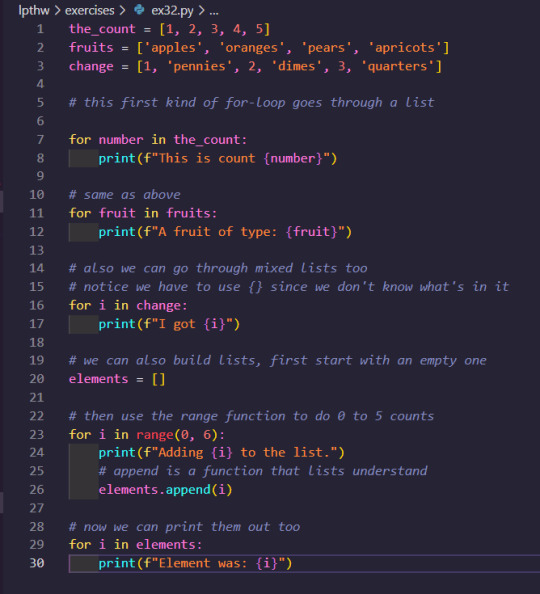
And the output:
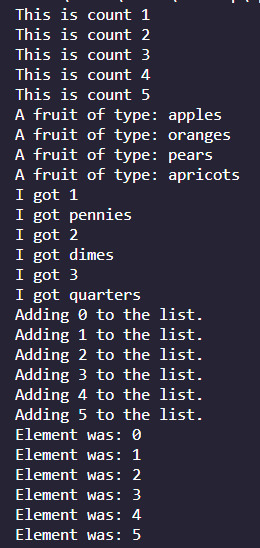
Up next is ex33.py! This is introducing While loops.
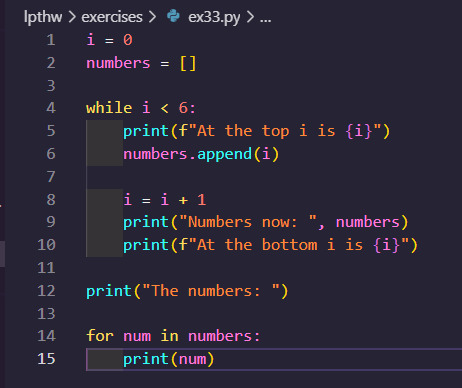
And then the output:
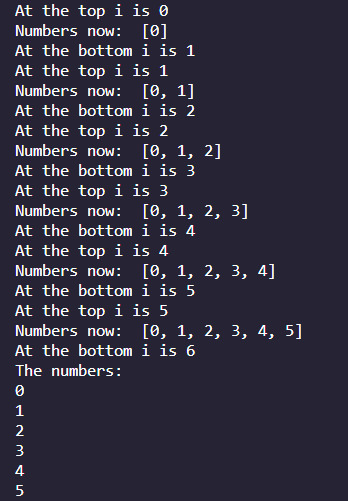
1 note
·
View note
Text
I am somewhat enjoying my position as "the mod people are allowed to complain about" for people who load up every possible compatible mod on top of K2+SE. Like it is kind of weird to see people call a pretty simple crafting setup an unholy abomination but whatever. Attention is attention.
Like, it feels like I have these people hostage almost? They are compelled for some reason to include every complexity adder that will technically run together. I could release more and more obnoxious mods that are technically compatible but worse and worse balanced as a form of like, adversarial performance art? Self-writing commentary on the strange culture of factorio players?
Zinc and nickel aren't even hard mods in the py/angel chemical morass sense, they're just intermediates on top of intermediates like vanilla is pretty obviously pointing towards but is too cowardly to actually commit to. There are no byproducts and no loops even with extra intermediates enabled. When I release sulfur* and helium** people are going to lose their goddamn minds. And gold if they use it with noble metals and SE. (they probably will.)
*not actually sulfur because it got away from me.
**not actually helium either.
12 notes
·
View notes
Text
it's 2 a.m and I have capybaracapybaracapybaracapybara ca-py-bara~ playing on loop in my head
0 notes
Text
Really long Blog about the whole week
I wasn't able to write anything on Wednesday and I thought that trying to write the blog on another day would interfere with my workflow, so ill make up for it with a longer blog today.
I had a meeting with Leo on Monday where I got feedback about the design of the trick
Leo advised that if I get more time I should make an explanatory chart of the booth, Something kind of like an Ikea instruction manual.
I also run past him the idea to change the schedule and doing the UI design next instead of the magician, and he agreed, as long as I thought it wouldn't interfere. So, I changed my Gantt chart to reflect this change. Basically all I had to do was switch the tasks of week 4 with week 9I felt like the change works as I'm only switching things around for character and UI design and already have rough concept for that character
During the week I also tried learning RenPy in order to see what was possible to do with the UI instead of trying to guess and hoping that it might work if I decide I want to put together a demo at the end of the project.
I also experimented a bit wit a colour palette and started thinking about the design of the start screen. For the start screen I looked at a few recent games and how they did it and sketched some thumbnails of them. (TGAA Chronicles, AI Solminum Files, Dredge, Mask of the Rose, Frog detective, and Tangle Tower)
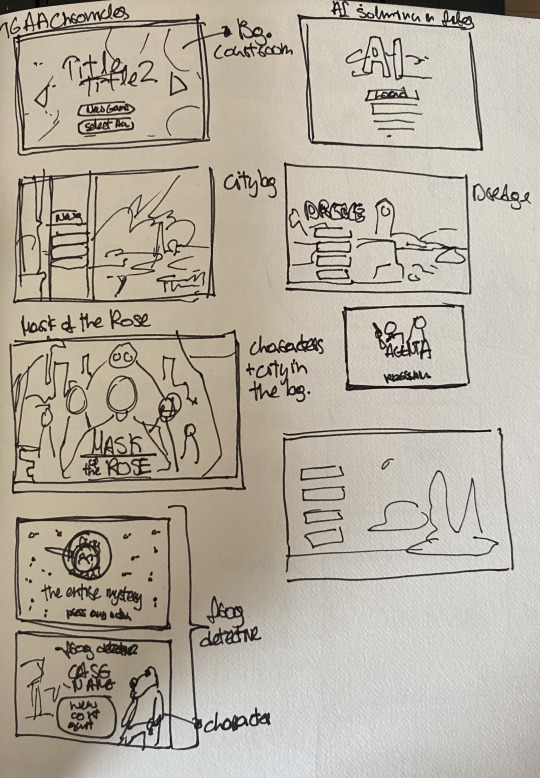
I saw that some of them used zoomed out locations from the game as screens for the menu, and I thought it could be a good idea to try that, as designing the locations was my next task so i would be getting ahead on and killing two birds with one stone.
I ended up coming up with this. The design of the cave exterior is pretty bland for now, but this is just the first idea, and it was very quickly sketched and put together. I liked the idea of having contrasting colours, so I experimented with bold orange and blue colours for it.
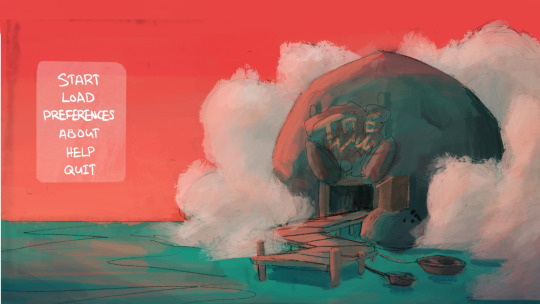
When I showed it in class, the feedback was that the orange/red colour is too intence and gives horror vibes, which wasn't really what I was trying to do.
On Wednesday we also had the symposia, which ended up being pretty useful because it turns out I was a bit confused about what the forefront posts are supposed to be
After the feedback I tried making the colour scheme for the menu screen
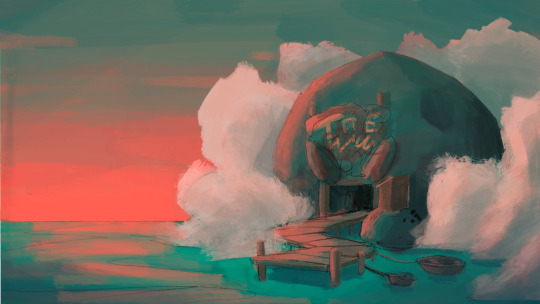
After that I spent some more time learning ren-py. What I found most useful in the very beginning was going into one of the default games that ren-py has, called 'the question' and editing the code to see how it aggected the game in real time, and which lines of code cause what. I only learned incredibly basic things like this, but it got me over the initial fear that I had about approaching programming
After that, I started following 'Coding with B and E' his Ren-Py for complete beginners.
Make Your Own Visual Novel! | Ren'Py Tutorial Part 1 - YouTube
I managed to learn a lot of the basics a lot quicker than I had anticipated. And the experience of learning it ranged from incredibly frustrating to really satisfying. I deceided that I wanted to see what I could do with what I had learned and created some placeholder art to use for a prototype of the game
the place holder art was for three in game locations, which was again killing two birds with one stone as it got me started coming up with ideas for the environments. I created three backgrounds with the hope that I will be able to reach my wishlist goal of adding an extra location.
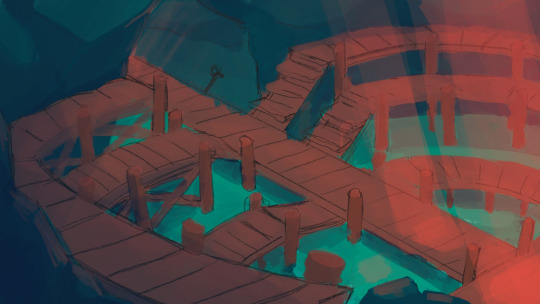
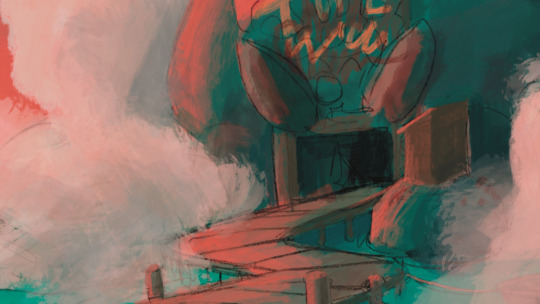
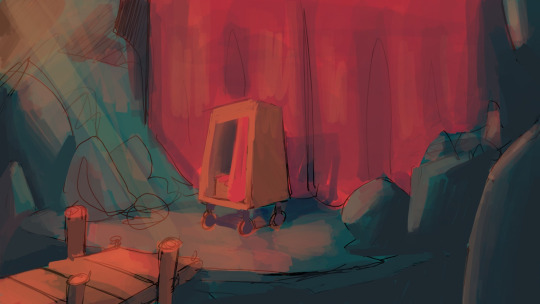
I ended up creating a game loop where you can move from location to location in the game using some arrow simbols. I also added some characters, as I imagined that in the game you will be able to click characters and talk to them. (In the prototype it just notifies you that the character has been clicked, since I don't have any of the dialogue yet.)
I was able to do this through the use of image buttons, where you can code an image to trigger certain action. I also added a hover state where there is some light glow around the image when it's hovered on so that it is easier to tell that something can be clicked.
I found image buttons incredibly difficult to figure out at first, but now I feel like I got the hang of them and I could use them for finding clues, creating UI screens ect.
So that gives me a more clear impression of what I could do in terms of UI.
I also created a small icon for the game. It's really small in the video but you might be able to see it.
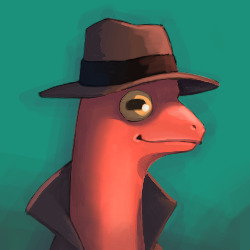
I also did some research about UI:
I watched this video about it:
(4) 5 TIPS for making prettier UI for games, faster. || Resources and Tools for User Interface Design - YouTube
And took some notes of what I thought could be useful in my sketchbook.
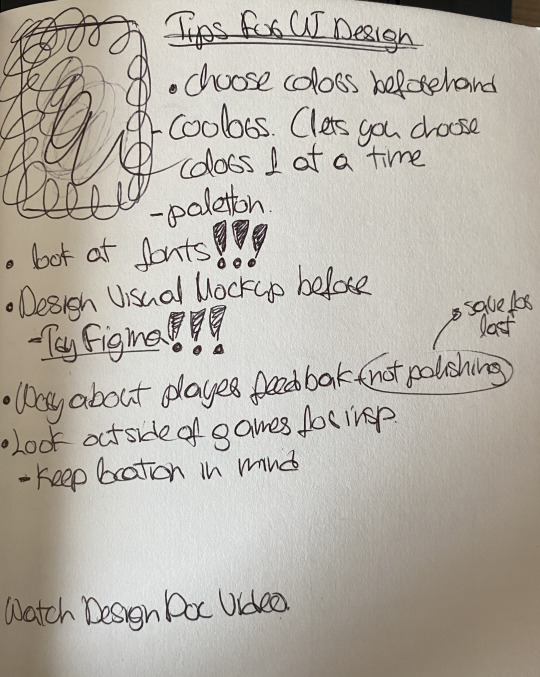
I also looked at Aviary attorney, as I really like the UI they have for the inventory and the and culprit UI)

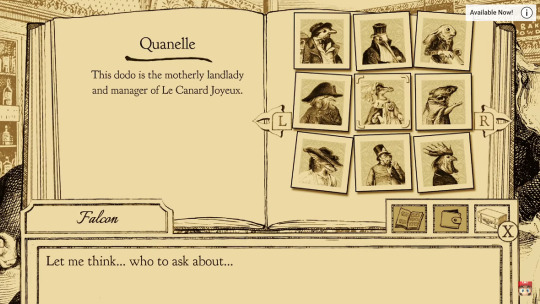
Then, I brainstormed some ideas about the UI in my sketchbook, and thumbailed some ideas about how the dialogue screen could look like, about a screen where you can examine the characters, and about a people's file screen, kind of like the Aviary attorney's culprit UI screen.
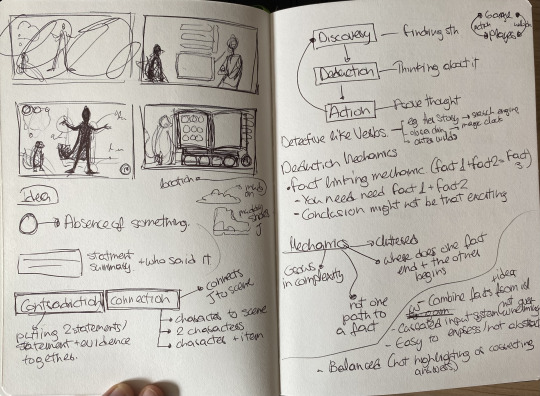
I also sketched out some ideas for what the puzzle's UI could look llike
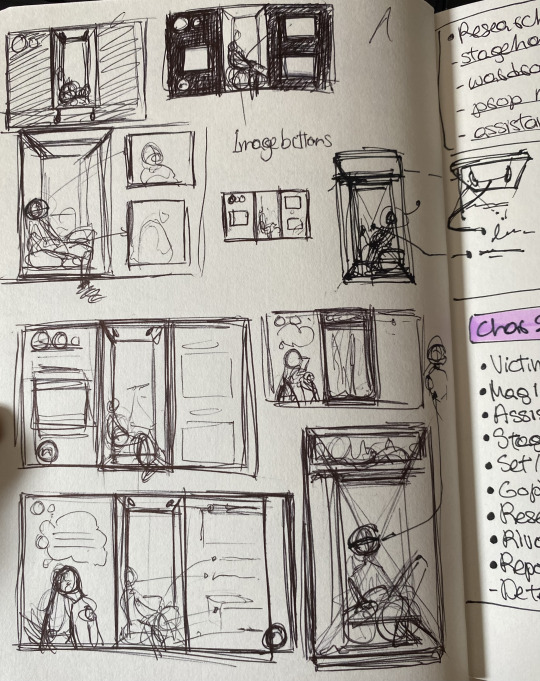
Then, I also came up with an idea for a mechanic where you can characters, clues or statements together and prove something by showing how they contradict or connect to each other.
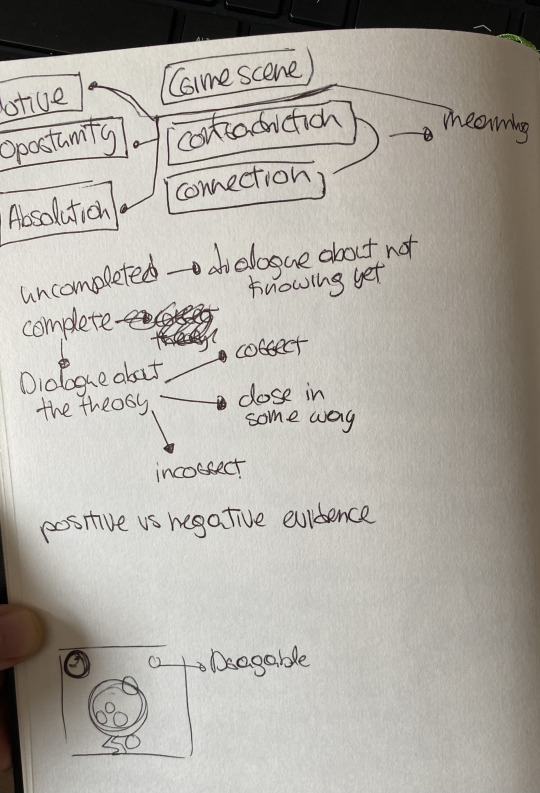
I am not exactly sure how I would implement that yet, and the idea is really fresh in my hed still ,so I think I need to think about it more.
Schedule for next weeks:
I still want to create a better design of the booth puzzle, so I have to try squeezing it in between working on other tasks. I've gotten more of an idea for the other designs byu creating the placeholder art, so I'm hoping that that will make the process of their design faster.
Also, even though I have done a lot of work in terms of UI and prototyping, I still have a long way to go with it, especially now that making something playable seems more possible. So I will have to try doing it in paralell with other tasks too
Bibliography:
(2019) AI: The Somnium Files on Steam. Available at: https://store.steampowered.com/app/948740/AI_The_Somnium_Files/ (Accessed: 23 August 2023).
(2021) The Great Ace Attorney Chronicles on Steam. Available at: https://store.steampowered.com/app/1158850/The_Great_Ace_Attorney_Chronicles/ (Accessed: 23 August 2023).
5 TIPS for making prettier UI for games, faster. || Resources and Tools for User Interface Design (2020). YouTube. 10 July. Available at: https://www.youtube.com/watch?v=cQVe6D2flpI&ab_channel=AmalieKae (Accessed: 23 August 2023).
Dredge on steam (2023) DREDGE on Steam. Available at: https://store.steampowered.com/app/1562430/DREDGE/ (Accessed: 23 August 2023).
Frog detective 1: The haunted island on steam (2018) Frog Detective 1: The Haunted Island on Steam. Available at: https://store.steampowered.com/app/963000/Frog_Detective_1_The_Haunted_Island/ (Accessed: 23 August 2023).
Make Your Own Visual Novel! | Ren’Py Tutorial Part 1 (2020). YouTube. 28 September. Available at: https://www.youtube.com/watch?v=vith10gG8L4&list=PL8gnyyQEz5CGTzHWF8thIfUg92ffs7T7P&ab_channel=CodingWithBandE (Accessed: 23 August 2023).
Mask of the rose on steam (2023) Mask of the Rose on Steam. Available at: https://store.steampowered.com/app/1769980/Mask_of_the_Rose/ (Accessed: 23 August 2023).
Tangle Tower on steam (2019) Tangle Tower on Steam. Available at: https://store.steampowered.com/app/359510/Tangle_Tower/ (Accessed: 23 August 2023).
0 notes
Text
Exploring the Power of Python: A Beginner's Guide
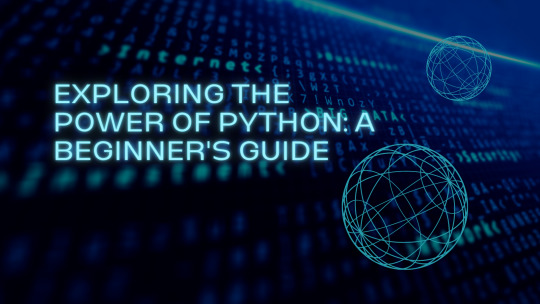
Introduction:
Python, with its simplicity and versatility, has emerged as one of the most popular programming languages. Whether you are a seasoned developer or just starting your programming journey, Python offers a wealth of possibilities and can be used for a wide range of applications. In this blog, we will delve into the world of Python, exploring its key features, benefits, and providing guidance for beginners to get started.
1. Why Python?
Python has gained immense popularity for several reasons:
Readability and simplicity: Python's syntax is clean and easy to understand, making it an ideal choice for beginners.
Large standard library: Python comes with a vast collection of modules and libraries, enabling developers to accomplish various tasks efficiently.
Cross-platform compatibility: Python code can run on different operating systems, including Windows, macOS, and Linux, providing flexibility and convenience.
Versatility: Python can be used for web development, data analysis, artificial intelligence, machine learning, automation, and much more.
2. Setting Up Python:
Before diving into Python programming, you'll need to set up your development environment. Follow these steps:
Download and install Python: Visit the official Python website (python.org) and download the latest version compatible with your operating system.
Installation process: Run the installer and follow the on-screen instructions. Make sure to select the option to add Python to your system's PATH.
3. Writing Your First Python Program:
Let's write a simple "Hello, World!" program to get started:
python
Copy code
print("Hello, World!")
Save the code with a .py extension, such as hello.py.
Open the command prompt (Windows) or terminal (macOS/Linux), navigate to the directory where the file is saved, and execute the following command: python hello.py.
You should see the output "Hello, World!" displayed on the screen.
4. Python Basics:
Variables and data types: Learn about different data types in Python, including integers, floats, strings, booleans, lists, dictionaries, and tuples.
Control flow: Understand conditional statements (if-else), loops (for and while), and logical operators (and, or, not) to control the flow of your program.
Functions: Explore how to define and use functions in Python to encapsulate reusable blocks of code.
5. Exploring Python Libraries:
Python boasts a vast ecosystem of libraries that extend its capabilities. Here are a few popular ones:
NumPy: A library for numerical computing, providing support for large, multi-dimensional arrays and mathematical functions.
Pandas: Used for data manipulation and analysis, Pandas offers powerful data structures and data analysis tools.
Matplotlib: A plotting library that helps create visualizations, charts, and graphs.
TensorFlow: An open-source library for machine learning and deep learning, widely used in building and training neural networks.
6. Resources and Further Learning:
To deepen your Python knowledge, take advantage of various resources:
Online tutorials and courses: Websites like Codecademy, Coursera, and Udemy offer comprehensive Python courses.
Documentation: Explore the official Python documentation to understand the language's specifics and gain insights into various modules and libraries.
Community support: Engage with the Python community through forums like Stack Overflow and Reddit. Join local Python user groups or attend meetups to connect with fellow enthusiasts.
Conclusion:
If you're looking for a reputable Python training institute in Trivandrum, look no further than IPCS GLOBAL. As a leading Python training institute in Trivandrum, we offer comprehensive courses designed to cater to the needs of beginners as well as experienced programmers.
At IPCS GLOBAL, we understand the importance of hands-on learning. Our courses provide a perfect blend of theoretical knowledge and practical exercises, allowing students to apply their learning in real-world scenarios. Our experienced instructors guide students through the fundamentals of Python, helping them build a strong foundation in the language.
As a Python training institute in Trivandrum, we offer flexible training options to suit your schedule. Whether you prefer classroom-based training or online sessions, we have got you covered. Our expert trainers are dedicated to ensuring that you gain a deep understanding of Python concepts and are equipped with the skills to tackle programming challenges confidently.
Visit website: https://ipcsglobal.com/software-development-python-training-institute-course-in-trivandrum/
0 notes
Text
Hel didn't skip a beat, just kept pulling tabs and piling up the cans until she was done. "That is... curious." She laughed as she pulled a weirdly shaped bowl off her belt and placed it on the floor. She pulled at the edges and it grew taller and wider. All the cans fit in it easily. "Neither of you spoke of it. I am much relieved, honestly. I'm no good at spectating first meetings."
She lifted her head to smile at her son and blindly pulled the sides of the bowl back into their previous dimensions, taking the cans with it. "Naturally, he likes you. Otherwise he would have come to me. He would come and ask if I was sure of this. If I had thought it through and understand what it means. He is as subtle as a wildfire. If he did not like you, he would not hesitate to try and dissuade me of keeping you."
She replaced the bowl on her belt, looping the leather through and buttoning it back up. Then she pushed herself up off the floor with her hands and walked over to him, "He's not wrong. Py is like clay. She is hard and cold. You need to take the time to warm her up and she will soften."
Hel folded her arms over her chest. Not an open gesture but her expression remained eager as she offered, "Well, ask me what you want to know. I'll answer to the best of my ability."
"I met Loki." Felet was watching her hands. "I didn't go looking for him or anything. I was just trying to find my way around, and I ran into him. I'm not sure if he liked me or not..."
Felet frowned, noticing for the first time the sheer number of cans his mother was de-tabbing. That was a lot. How long had he been down here?
"And Pyira doesn't seem to like me, but Emrys says she's just like that and not to take it seriously." Felet pressed hus hand to his heart, yep, it was racing. Too many energy drinks. "I don't want to rush to meet the whole family just... I'd like to know a little bit about everyone. So it's not so intimidating, you know."
122 notes
·
View notes